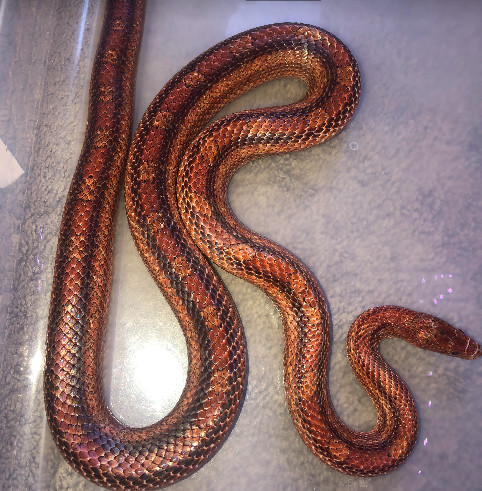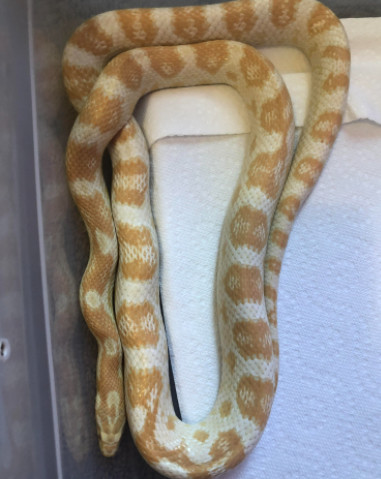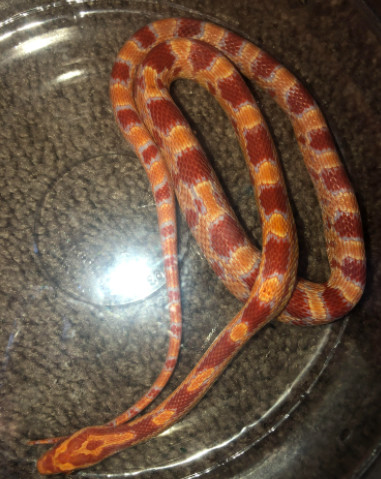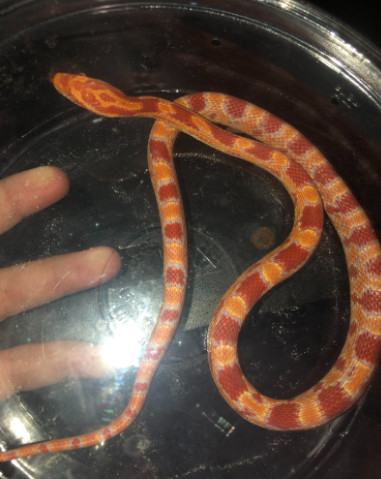Hi guys, so I have recently acquired a handful of snakes and want to hear what you guys think their morphs are. I believe the first one is a diffused stripe? The second one I think is butter, and the 3rd one was sold to me as an “intense” reverse okeetee. I assumed they meant extreme reverse okeetee and went ahead and bought him to pair to my extreme reverse okeetee female in 2023. Ignore the fact that the reverse okeetees just ate yesterday and look a little chunky.



Those were the “diffused stripe” pictures.

This girl is what I believe to be a butter


Those were pictures of the “intense reverse okeetee”

Here is a picture of my extreme reverse okeetee female for reference.
In picture number three it looks like you’re squeezing the noodle and it’s giving me anxietyyyyyyy 
 pretty snakes tho.
pretty snakes tho.
The “Diffused Stripe” animal is definitely not a Stripe. Your other IDs seem correct.
I’m not  , hes just squirming around like a lunatic
, hes just squirming around like a lunatic  Im lucky I got that picture. From this vantage point I can see how it does look like that though, but don’t worry I wouldn’t squeeze him.
Im lucky I got that picture. From this vantage point I can see how it does look like that though, but don’t worry I wouldn’t squeeze him.
What makes you say hes not a stripe?
Silly snakey, doesn’t he know you’re trying to take pictures of him? 


Those black lines down the back can appear on any Corn Snake with normal amounts of melanin. They are on many WC Corn Snakes. Stripe morph Corn Snakes have stripes that replace the normal pattern, not just go on top of it like in the snake pictured. Look between the black lines and you will see the blotches.
Oh, but he cant be wild-caught because he’s a diffused right?
First one is definitely not a stripe. He wouldn’t have those saddles if he was a stripe. Those dark lines are common in old school bloodreds and some wild caught corns. I would say he is simply diffused.
To me, the reverse okeetee doesn’t have quite wide enough borders to classify as an okeetee, but he does look like a very bright and saturated amel. As for the butter, I would like to see some more pictures in natural light. Butter is probably correct.
Hi, I was just looking back on this thread and I started to wonder…what is the difference between a diffused, bloodred, and say a masque. Are there any reasons as to why he cant be one of the other two?
There is some debate about exactly what a bloodred is, but to me, it consists of three genes - diffused, masque, and a reddening gene, usually red factor.
Diffused is the trait that makes the snake have a clear belly with no belly checkers. It also cleans up the side pattern, which is why it’s called diffused. Diffused is almost always combined with masque, so much so that you will almost never see someone list a corn snake as a diffused masque. Usually they’ll just say diffused. Masque in general gets kind of ignored anyway though!
Masque is the trait that creates that ‘bald’ head pattern. It also will create split belly checkers (in the case of diffused plus masque, the belly checkers will be completely gone).
Bloodred would be those two genes, plus a gene to make the snake extra red. The original bloodreds were a brick red color and over time, as the morph has been outcrossed, they’ve gotten more orangey. Personally, I reserve the bloodred moniker for diffused snakes that are solid red.
In the case of the original snake, it could possibly be considered a bloodred, but I don’t think it’s quite red enough to be carrying a red factor gene. And it still has quite a bit of pattern visible.
All that being said, lots of people still use diffused and bloodred interchangeably. If someone wanted to call this snake bloodred, I wouldn’t argue.
I went into a bit more depth here if you want to do some more reading: https://community.morphmarket.com/t/morphpedia-corn-snakes-diffused/24529
So, are what he has on his belly not considered belly checkers?
No they are not. That’s just color bleed from the sides. A lot of diffused and bloodred corns have exactly that.
Thanks a bunch, I was really just trying to figure out if he was Masque or not. But as I read in your other post, it’s rare for them to not have it but there’s no definite determining factors, correct?
If you can get a clear picture of his head, we can try to figure out if he is masque as well. He likely is, but I couldn’t really tell from that photo. Once they get to be adults and the head color really fills in, it can be hard to tell.
Also, do you know how old he is?
No clue, got him a few months back and the owner didn’t know.
Sometimes those lines down the back, plus the darkening of the color, can be indicative of an elderly corn.
Thats interesting, Hes currently in brumation right now (as a backup male really). Is there any real way to determine his age?
No, unfortunately not.